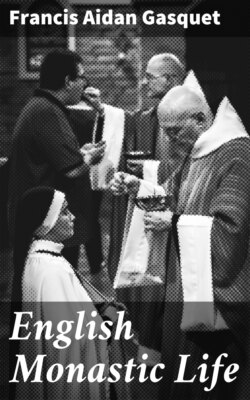Читать книгу English Monastic Life - Francis Aidan Gasquet - Страница 11
На сайте Литреса книга снята с продажи.
4. THE KITCHEN
ОглавлениеTable of Contents
Near to the refectory was, of course, the conventual kitchen. At Canterbury this kitchen was a square of some forty-five feet; at Durham it was somewhat smaller; and at Glastonbury, Worcester, and Chester the hall was some thirty-five feet square. A small courtyard with the usual offices adjoined it; and this sometimes, as at Westminster and Chester, had a tower and a larder on the western side. According to the Cluniac constitutions there were to be two kitchens: the one served in weekly turns by the brethren, the other in which a good deal of the food was prepared by paid servants. The first was chiefly used for the preparation of the soup or pottage, which formed the foundation of the monastic dinner. The furniture of this kitchen is minutely described in the Custumals: there were to be three caldaria or cauldrons for boiling water: one for cooking the beans, a second for the vegetables, and a third, with an iron tripod to stand it upon, to furnish hot water for washing plates, dishes, cloths, etc. Secondly, there were to be four great dishes or vessels: one for half-cooked beans; another and much larger one, into which water was always to be kept running, for washing vegetables; a third for washing up plates and dishes; and a fourth to be reserved for holding a supply of hot water required for the weekly feet-washing, and for the shaving of faces and tonsures, etc. In the same way there were to be always in the kitchen four spoons: the first for beans, the second for vegetables, the third (a small one naturally) for seasoning the soup, and the fourth (an iron one of large size) for shovelling coals on to the fire. Besides these necessary articles, the superior was to see that there were to be always at hand four pairs of sleeves for the use of the servers, that they might not soil their ordinary habits; two pairs of gloves for moving hot vessels, and three napkins for wiping dishes, etc., which were to be changed every Thursday. Besides these things there were, of course, to be knives, and a stone wherewith to sharpen them; a small dish to get hot water quickly when required; a strainer; an urn to draw hot water from; two ladles; a fan to blow the fire up when needed, and stands to set the pots upon, etc.
Larger Image
The work of the weekly cooks is also carefully set out in these constitutions. These officials were four in number, and, upon the sign for vespers, after making their prayer, they were to proceed to the kitchen and obtain the necessary measure of beans for the following day. They then said their vespers together, and proceeded to wash the beans in three waters, putting them afterwards into the great boiling-pot with water ready for the next day. After Lauds on the following day, when they had received the usual blessing for the servers, after washing themselves they proceeded to the kitchen and set the cauldron of beans on the fire. The pot was to be watched most carefully lest the contents should be burnt. The skins were to be taken off as they became loosened, and the beans were to be removed as they were cooked. When all had been finished, the great cauldron was to be scoured and cleaned “usque ad nitidum.” Directly the beans had been removed from the fire, another pot was to be put in its place, so that there might always be a good supply of water for washing plates and dishes. These, when cleaned, were to be put into a rack to dry; this rack was to be constantly and thoroughly scoured and kept clean and sweet.
When the cooking of this bean soup had progressed so far, the four cooks were to sit down and say their Divine Office together whilst the hot water was being boiled. A third pot, with vegetables in cold water, was to be then made ready to take its place on the fire, after the Gospel of the morning Mass. When the daily Chapter, at which all had to be present, was finished, the beans were again to be put on the fire and boiled with more water, whilst the vegetables also were set to cook; and when these were done the cooks got the lard and seasoning, and, having melted it, poured it over them. Two of the four weekly cooks now went to the High Mass, the other two remaining behind to watch the dinner and to put more water into the cooking-pots when needed. When the community were ready for their meal, the first cook ladled out the soup into dishes, and the other three carried them to the refectory. In the same way the vegetables were to be served to the community, and when this had been done the four weekly cooks proceeded at once to wash with hot water the dishes and plates which had been used for beans and vegetables, lest by delay any remains should stick to the substance of the plate and be afterwards difficult to remove.
